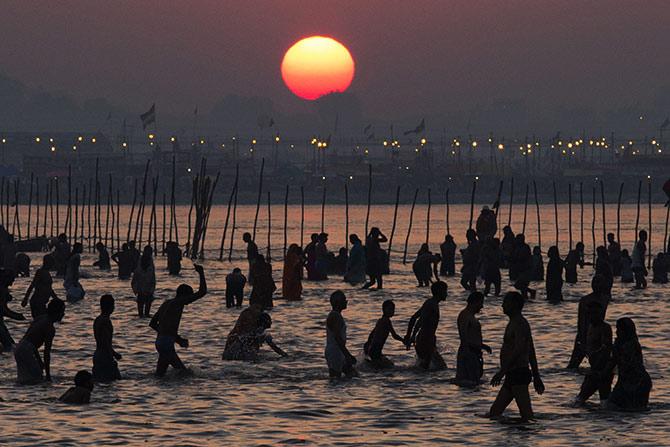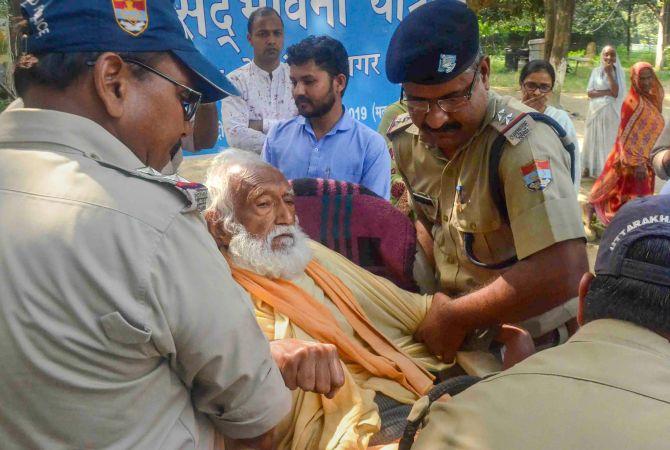'Two have already sacrificed their lives.'
'How many more shall need to sacrifice before the government listens?'
'Four, five or six? They are ready, waiting.'
After Ganga campaigner G D Agrawal's death, a Haridwar ashram's sadhus are on a relay fast unto death.
Kumar Sambhav Shrivastava reports.

At Matri Sadan, a deceptively serene ashram on the banks of the Ganga in Haridwar, Brahmachari Atmabodhanand is sitting on a fast unto death. The 26-year-old computer science student-turned-seer has taken over the 'responsibility' from G D Agrawal, the 86-year-old scientist-seer who fasted to death when the Union government did not listen to his demands to save the Ganga.
Brahmachari Atmabodhanand is not alone. Thirty-nine-year-old Mahant Gopaldas too been on fast unto death. He has been admitted to the All India Institute of Medical Sciences in Rishikesh. A third, Swami Punyanand, 61, is preparing to follow them. He has moved to a fruit-only diet, waiting in the wings to take over the 'responsibility'.
"When I die, Swami Punyanandji shall take over. He shall be the next to sacrifice," says Atmabodhanand, in a calm voice that betrays nothing but resolve.
"This government wants blood. We will give it blood," says their guru, Swami Shivanand, a 71-year-old ascetic who heads the Matri Sadan Ashram.
They all want the Ganga to flow unhindered from the Himalayas down. The government wants to build dams -- dozens of them. They are prepared, they say, to continue fasting to death, one by one, till the government relents.
"Two have already sacrificed their lives. How many more shall need to sacrifice before the government listens? Four, five or six? They are ready, waiting. If that is what it takes," adds Shivanand.
This is the way of Matri Sadan and its seers. They fast, sometimes unto death.
Since 1997, when the ashram was established, its seers have observed fasts that ran over 1,940 days -- or over five years -- collectively. They also litigate and file Right To Information applications, all for causes they believe are in the larger public interest, such as safeguarding the Ganga and getting rid of corruption that corrodes the river basin.
In the process, they have been beaten, threatened, arrested, and killed.
Agrawal's death seems to have only burnished their determination to continue with their ways.

The unevenly paved cement road cuts through slums to reach the ashram and its fasting seers on the bank of the Ganga. A few shabbily constructed quarters on one side and mango and litchi trees spread across the campus make up the spartan space. Oddly, there is no temple on the campus.
Instead, the trail from the entrance gate to the quarters is lined with a series of banners displaying visual evidence of the damage the dams and sand mining has done to the Ganga.
In one of those quarters, sits the frail but stoic Atmabodhanand, wearing a crisp white dhoti and a same colour sweater. Behind him hangs a picture of late G D Agrawal, and the two other seers who have died fasting unto death for the river.
"What is better than dying for Gangaji; to die fighting corruption? I have nothing to gain from or lose to this society," he says.
This spiritual and moral force, derived from self-sacrifice and combined with science-based activism, makes Matri Sadan the fulcrum of an unique environment movement, which could potentially blow up in the face of the Bharatiya Janata Party-led Union government.

"This government is only fulfilling the demands of corporates. They (people in the government) keep chanting religion-religion but have no concerns for Gangaji. (Prime Minister Narendra Damodardas) Modiji came to power in the name of Gangaji. He said he was Gangaji's son, but now is busy earning profit by selling the mother," says Atmabodhanand.
"I consider Gangaji my mother. I can't see her being murdered. That's why I am throwing myself into this," he adds.
The fasting seers have four demands. All four, they say, when met, shall keep the Ganga flowing unhindered.
They want the government to cancel all under-construction and proposed dams on the river and its tributaries in its upper Himalayan reaches -- from Gomukh down to Haridwar.
Second, ban sand and gravel mining from the Ganga.
Third, they demand a Ganga Protection Act be passed by Parliament.
And, lastly, they want the government to constitute a Ganga Bhakt Parishad, to keep a watch on regulatory matters of the river.
These are the demands that Agrawal died asking for. Before he renounced the material world and devoted himself to 'the service of the Ganga' taking on the name of Swami Gyan Swarup Sanand, Agrawal headed the civil and environmental engineering department at the Indian Institute of Technology-Kanpur.
He served as the first member secretary of the Central Pollution Control Board of India and was part of several government panels on the Ganga's conservation. Then he gave it all up, to work and fast to save the Ganga.
Between 2009 and 2013, when Agrawal fasted, the United Progressive Alliance government often keeled over, agreeing to several of his demands, including the cancellation of three dams on tributaries of the Ganga in Uttarakhand. But the BJP-led National Democratic Alliance government was unrelenting.
Agarwal was not directly affiliated to Matri Sadan -- he took the initiation of a monk's life from Shankaracharya Swami Swaroopanand Saraswati of Joshi Mutt, one of the four institutions considered cardinal in Hinduism, but he chose Matri Sadan to observe most of his fasts.
After he began his last fast on June 22, 2018, at Matri Sadan, he wrote several letters to Prime Minister Modi and Union Minister of Water Resources, River Development and Ganga Rejuvenation Nitin Gadkari, raising his demands. The government did not relent until it was too late.
With Agrawal still on fast for more than 100 days, his health failing rapidly on October 10, the Ganga Rejuvenation ministry blinked and passed a notification ensuring that within three years at least 20 per cent of the monthly average flow of water would be maintained in Ganga in all seasons. Gadkari said the government had agreed to almost all of Agrawal's demands.
But, next day, in a video recorded from his hospital bed, Agrawal dismissed the environment flow notification as 'stupid' and having 'no scientific basis'.
He noted that a consortium of IITs had recommended 50 per cent of the monthly average flow as the minimum environmental flow for Ganga. There was no scientific basis to reduce the low to 20 per cent, he said. A few hours later he was dead.
On November 1, we sent queries to Gadkari noting that other seers continued in place of Agrawal to fast unto death claiming the government had not addressed Agrawal's demands. His ministry responded, 'The National Mission for Clean Ganga is acting on a war-footing to sanction and execute projects to clean River Ganga and maintain its unhindered flow (Aviralta and Nirmalta).'
It said inter-ministerial consultations were going on the draft Ganga Bill and the river-bed mining was being regulated as per the National Green Tribunal orders.
'The issue of hydel projects needs a larger view and comprehensive analysis among stakeholders before a decision in this regard is made,' the ministry added.

"Merely releasing some percentage of water from the dams does not mean anything for Ganga rejuvenation. There are several scientific reasons why Agrawal asked for the dams to be cancelled," says Mallika Bhanot of Ganga Ahvaan, a volunteer-based organisation that works on Ganga conservation.
Shivanand, the Matri Sadan's founder, feels Agrawal was betrayed by the government.
"Many officials from the water resources ministry would come to meet Swami Sanandji (Agrawal), but he never got any replies to his questions in writing. His demand for aviral (free-flowing) Ganga was not met even after Narendra Modi came to power promising us that Ganga will go back to its pristine glory. They have done nothing," he says.
Agrawal wrote as much to the prime minister months before he died, 'I had great confidence that after your becoming the prime minister, you would think seriously about Gangaji because you have yourselves stated in the run-up to 2014 elections in Banaras that you have come there because of the call given to you by Ma Gangaji... but in the past four years all actions undertaken by your government have not at all been gainful to Gangaji.'
In the letter, he pointed out that he had undertaken several fasts in the past and then prime minister Dr Manmohan Singh cancelled a big dam on Ganga on his insistence, even when 90 per cent of the work on the project was complete.
His death had been preceded by the Rashtriya Swayamsevak Sangh, the BJP's parent organisation, too reaching out to the ashram to mediate.
"Krishnagopalji (the RSS Sah Sarkaryavah) met with us for four hours in September," says Shivanand. "He said if the previous government could cancel three projects on the insistence of Sanandji (Agrawal), then this government should cancel at least four."
"He said he would take up the issue with the government. When the government came out with the dubious environment flow notification we followed up again with Krishnagopalji."
"This time he turned around and told us that we should settle for whatever was being offered by the government," Shivanand adds.
We called RSS Prachar Pramukh Arun Kumar to get his response. Kumar insisted the query should be made to to Rajiv Tuli, another RSS functionary. E-mail queries to Tuli did not elicit a response.
Now Atmabodhanand, Gopaldas and Punyanand have staked their life for the same demands.
"These saints who are fasting are not the so-called leftists or from NGOs, which the government likes to blame for opposition to projects. Agrawalji's three generations have been associated with the RSS," says Himanshu Thakkar of the South Asian Network on Dams, Rivers and People.
The ashram was established by Shivanand in 1997. He lived a celibate life, got an MSc from Jadavpur University and taught chemistry at a higher secondary school in Kolkata. In 1994, he quit his job to set up Matri Sadan. He says he was inspired to do so while meditating at Badrinath.
Through donations he bought four acres of land on the bank of the Ganga in Haridwar for Rs 1 million. Soon Shivanand and his disciples began their first campaign -- against vehicles passing through the Ganga river stream discharging fuel in it.










